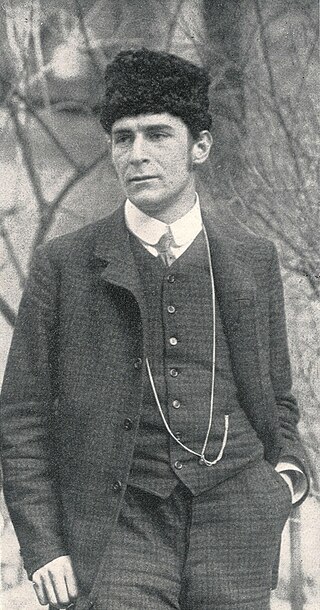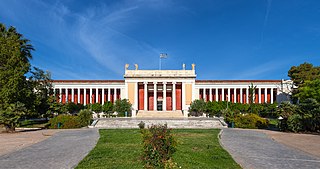Related Research Articles

The British Museum is a public museum dedicated to human history, art and culture located in the Bloomsbury area of London. Its permanent collection of eight million works is among the largest and most comprehensive in existence. It documents the story of human culture from its beginnings to the present. The British Museum was the first public national museum to cover all fields of knowledge.

The Lewis chessmen or Uig chessmen, named after the island or the bay where they were found, are a group of distinctive 12th-century chess pieces, along with other game pieces, most of which are carved from walrus ivory. Discovered in 1831 on Lewis in the Outer Hebrides of Scotland, they may constitute some of the few complete, surviving medieval chess sets, although it is not clear if a set as originally made can be assembled from the pieces. When found, the hoard contained 93 artifacts: 78 chess pieces, 14 tablemen and one belt buckle. Today, 82 pieces are owned and usually exhibited by the British Museum in London, and the remaining 11 are at the National Museum of Scotland in Edinburgh.

Christie's is a British auction house founded in 1766 by James Christie. Its main premises are on King Street, St James's in London, at Rockefeller Center in New York City and at Alexandra House in Hong Kong. It is owned by Groupe Artémis, the holding company of François-Henri Pinault. Sales in 2015 totalled £4.8 billion. In 2017, the Salvator Mundi was sold for $400 million at Christie's in New York, at the time the highest price ever paid for a single painting at an auction.

Franz Moritz Wilhelm Marc was a German painter and printmaker, one of the key figures of German Expressionism. He was a founding member of Der Blaue Reiter, a journal whose name later became synonymous with the circle of artists collaborating in it.

The University of Basel is a university in Basel, Switzerland. Founded on 4 April 1460, it is Switzerland's oldest university and among the world's oldest surviving universities. The university is traditionally counted among the leading institutions of higher learning in the country.

Paul Hermann Müller, also known as Pauly Mueller, was a Swiss chemist who received the 1948 Nobel prize in Physiology or Medicine for his 1939 discovery of insecticidal qualities and use of DDT in the control of vector diseases such as malaria and yellow fever.

Edwin Parker "Cy" Twombly Jr. was an American painter, sculptor and photographer. He belonged to the generation of Robert Rauschenberg and Jasper Johns.

The National Archaeological Museum in Athens houses some of the most important artifacts from a variety of archaeological locations around Greece from prehistory to late antiquity. It is considered one of the greatest museums in the world and contains the richest collection of Greek Antiquity artifacts worldwide. It is situated in the Exarcheia area in central Athens between Epirus Street, Bouboulinas Street and Tositsas Street while its entrance is on the Patission Street adjacent to the historical building of the Athens Polytechnic university.
British and Irish country house contents auctions are usually held on site at the country house, and have been used to raise funds for their owners, usually before selling the house and estate. Such auctions include the sale of high quality antique paintings, furniture, objets d'art, tapestries, books, and other household items.

Solomon's knot is a traditional decorative motif used since ancient times, and found in many cultures. Despite the name, it is classified as a link, and is not a true knot according to the definitions of mathematical knot theory.

The Lansdowne Heracles is a Roman marble sculpture of about 125 CE. Today it is in the collection of the J. Paul Getty Museum's Getty Villa on the Malibu Coast, Los Angeles. The statue represents the hero Heracles as a beardless Lysippic youth grasping the skin of the Nemean lion with his club upon his shoulder. The work was discovered in 1790 in Tivoli, Italy, on the site of Hadrian's Villa, where many fine Hadrianic copies and pastiches of Greek sculptures had been discovered since the 16th century. Today, the sculpture is considered to be an example of Roman-era improvisations on the Greek sculptural style of the fourth century BCE rather than a copy of a specific Greek original.

The Madonna and Child with Saints Luke and Catherine of Alexandria, also known simply as Holy Conversation, is a painting by the Italian Renaissance master Titian. It is one of his several versions of the canonical image of the Madonna and Child.

Friedrich Fichter was a professor of inorganic chemistry at the University of Basel. His main field of interest was electrochemistry. He initiated the founding of the scientific journal Helvetica Chimica Acta.

Johan Hermann Wilhelm Rupe was a professor of organic chemistry at the University of Basel. His main field of interest was terpenes and campher as well as optical activity.
Helly Nahmad is an American art dealer and art collector. In 2000, he founded the Helly Nahmad Gallery in Manhattan, New York, which holds several fine art exhibitions each year featuring artists such as Pablo Picasso, Chaïm Soutine, Francis Bacon, and Giorgio de Chirico.

John Doubleday was a British craftsperson, restorer, and dealer in antiquities who was employed by the British Museum for the last 20 years of his life. He undertook several duties for the museum, not least as a witness in criminal trials, but was primarily their specialist restorer, perhaps the first person to hold the position. He is best known for his 1845 restoration of the severely-damaged Roman Portland Vase, an accomplishment that places him at the forefront of his profession at the time.

The Colossus of Rhodes is a 1954 oil painting by the Spanish surrealist Salvador Dalí. It is one of a series of seven paintings he created for the 1956 film Seven Wonders of the World, each depicting one of the wonders. The work shows the Colossus of Rhodes, the ancient statue of the Greek titan-god of the sun, Helios. The painting was not used for the film and was donated to the Kunstmuseum Bern in 1981, where it remains.
Iphigenia Photaki was a Greek organic chemist remembered for her contributions in peptide chemical synthesis, especially in the synthesis of biologically/enzymatically active peptides.
Terence Croft Mitchell was a British archaeologist, scholar and curator. He was Keeper of Western Asiatic Antiquities at the British Museum from 1985 to 1989. He specialised in West Semitic languages, Near Eastern archaeology, and also took an interest in Biblical matters from an evangelical Christian position.
Heinz Kisters was a German entrepreneur, art dealer and art collector.
References
- Hubert Bloch: Prof. Dr. phil. Hans Erlenmeyer. 1900–1967. In: Basler Stadtbuch 1969, S. 37–40 Digitalisat
- Wolfram Nagel: Hans Erlenmeyer. In: Archiv für Orientforschung 22, 1968/69, S. 213–214.
- Bernhard Prijs: Chymia Basiliensis. Episoden aus der Basler Chemiegeschichte. S. Karger, Basel u. a. 1983, ISBN 3-8055-3786-7, S. 114–115.
- Rudolf Vierhaus (Hrsg.): Deutsche Biographische Enzyklopädie. Bd. ?, K. G. Saur, München 2006, S. ?.
- 1 2 3 "Erlenmeyer, Hans". hls-dhs-dss.ch (in German). Retrieved 2023-03-16.
- 1 2 "Nomination%20Chemistry%201943%209-0". NobelPrize.org. 2020-04-01. Retrieved 2023-03-17.
- ↑ Reif, Rita (1990-07-06). "Auctions". The New York Times. ISSN 0362-4331 . Retrieved 2023-03-16.
- ↑ "Tablet with 'the earliest known record of any personal name in history' offered at Bloomsbury Auctions | Antiques Trade Gazette". www.antiquestradegazette.com. Retrieved 2023-03-16.
- ↑ Ancient Near Eastern Texts from the Erlenmeyer Collection. Christie, Manson & Woods Limited. 1988.
- ↑ Woods, Christie, Manson & (1989). The Erlenmeyer Collection of Cretan Seals. Christie's, Manson & Woods.
- ↑ Woods, Christie, Manson & (1989). The Erlenmeyer Collection of Ancient Near Eastern Stamp Seals and Amulets: The Property of the Erlenmeyer Stiftung which Will be Sold at Christie's Great Rooms on Tuesday, 6 June 1989. Christie, Manson & Woods.
- ↑ Cycladic and Classical Antiquities from the Erlenmeyer Collection: The Property of the Erlenmeyer Stiftung (a Foundation for Animal Welfare); Day of Sale: Monday, 9th July 1990. Sotheby's. 1990.
- ↑ "Cycladic and classical antiquities from the Erlenmeyer collection". primo.getty.edu. Retrieved 2023-03-16.